德国银行资金模式结构和盈利能力的变化【外文翻译】
- 格式:doc
- 大小:51.50 KB
- 文档页数:6

Finance & Accounting2012 07・财务与会计63长期的扩张兼并与收购等资本运营历程,使如今的银行机构大都组织复杂、机构庞大、层次多样,而且产品同质化严重,竞争基本呈饱和状态。
如此严峻形势下,加强内部控制与挖潜成为银行关注的焦点,但如果只在操作流程、风险识别等既存组织框架内实施,效果往往不如人意。
当今以德国德累斯顿银行为代表的欧洲商业银行以客户导向型的内控原则来调整内部结构,模拟矩阵式组织,将业务线条纵向贯穿,功能线条采取派驻制,在增强内部制衡机制的同时向客户提供一揽子金融服务。
这反映了现代商业银行从调整组织架构入手实施内部控制的新趋势,也为我国商业银行降低业务与操作风险、加强内部控制提供了一条思路。
一、调整组织架构的动因上世纪80年代前,银行业在资金市场上还处于卖方市场的地位,因此欧洲商业银行主要采用以产品为导向的内部结构,这是一种根据服务品种来设置相应部门的比较简单的组织结构,一般设有管理部、存款部、贷款部、外汇业务部、企业部、产品部等,而且,包括财务管理、人力资源管理、信息管理和风险管理(功能部门)等在内的内部控制均集中在管理部门。
目前,我国银行大都还是采用这种组织架构。
随着经济的发展与科技的进步,以产品为导向的传统组织架构与运行模式和环境变化越来越不相协调。
首先,客户需求日益多样化,对银行的要求往往不再是某种单一的产品或服务,而是希望银行提供一揽子金融服务。
在传统的组织结构下,后台不能很好地为前台服务,不能满足客户金融服务需要。
其次,资金市场已逐步由卖方市场转向买方市场,客户资源日渐成为“稀缺”资源,商业银行面临的市场竞争日益激烈,为了争取客户、开发市场,银行需要按客户导向型的原则来设置内部结构。
第三,银行各部门、岗位的交易金额增大,违规损失也大,缺失有效的制衡与监管等内部控制机制。
第四,既存组织结构各岗位的独立性越来越强,前、后台协同服务严重脱节,阻碍了产品推出与市场开拓。
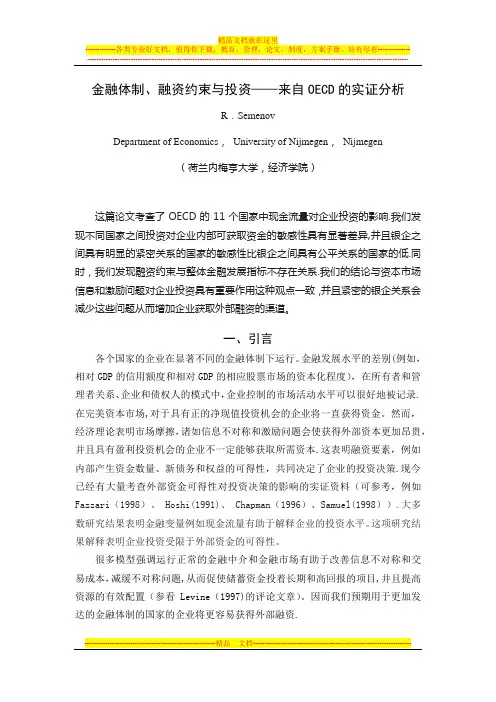
金融体制、融资约束与投资——来自OECD的实证分析R.SemenovDepartment of Economics,University of Nijmegen,Nijmegen(荷兰内梅亨大学,经济学院)这篇论文考查了OECD的11个国家中现金流量对企业投资的影响.我们发现不同国家之间投资对企业内部可获取资金的敏感性具有显著差异,并且银企之间具有明显的紧密关系的国家的敏感性比银企之间具有公平关系的国家的低.同时,我们发现融资约束与整体金融发展指标不存在关系.我们的结论与资本市场信息和激励问题对企业投资具有重要作用这种观点一致,并且紧密的银企关系会减少这些问题从而增加企业获取外部融资的渠道。
一、引言各个国家的企业在显著不同的金融体制下运行。
金融发展水平的差别(例如,相对GDP的信用额度和相对GDP的相应股票市场的资本化程度),在所有者和管理者关系、企业和债权人的模式中,企业控制的市场活动水平可以很好地被记录.在完美资本市场,对于具有正的净现值投资机会的企业将一直获得资金。
然而,经济理论表明市场摩擦,诸如信息不对称和激励问题会使获得外部资本更加昂贵,并且具有盈利投资机会的企业不一定能够获取所需资本.这表明融资要素,例如内部产生资金数量、新债务和权益的可得性,共同决定了企业的投资决策.现今已经有大量考查外部资金可得性对投资决策的影响的实证资料(可参考,例如Fazzari(1998)、 Hoshi(1991)、 Chapman(1996)、Samuel(1998)).大多数研究结果表明金融变量例如现金流量有助于解释企业的投资水平。
这项研究结果解释表明企业投资受限于外部资金的可得性。
很多模型强调运行正常的金融中介和金融市场有助于改善信息不对称和交易成本,减缓不对称问题,从而促使储蓄资金投着长期和高回报的项目,并且提高资源的有效配置(参看Levine(1997)的评论文章)。
因而我们预期用于更加发达的金融体制的国家的企业将更容易获得外部融资.几位学者已经指出建立企业和金融中介机构可进一步缓解金融市场摩擦。
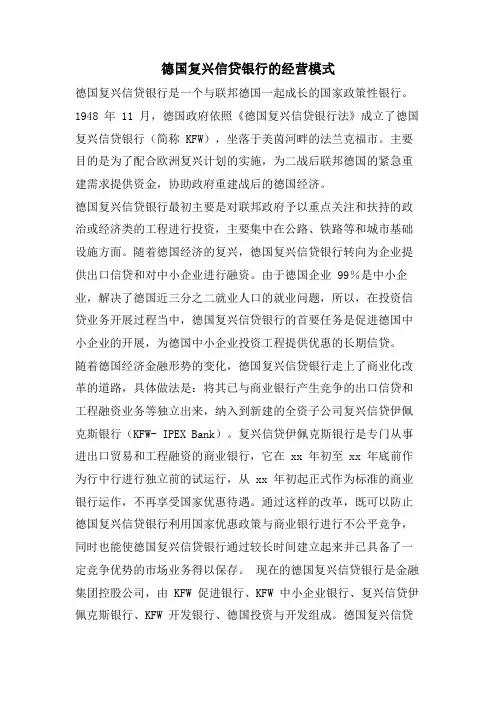
德国复兴信贷银行的经营模式德国复兴信贷银行是一个与联邦德国一起成长的国家政策性银行。
1948 年 11 月,德国政府依照《德国复兴信贷银行法》成立了德国复兴信贷银行(简称 KFW),坐落于美茵河畔的法兰克福市。
主要目的是为了配合欧洲复兴计划的实施,为二战后联邦德国的紧急重建需求提供资金,协助政府重建战后的德国经济。
德国复兴信贷银行最初主要是对联邦政府予以重点关注和扶持的政治或经济类的工程进行投资,主要集中在公路、铁路等和城市基础设施方面。
随着德国经济的复兴,德国复兴信贷银行转向为企业提供出口信贷和对中小企业进行融资。
由于德国企业 99%是中小企业,解决了德国近三分之二就业人口的就业问题,所以,在投资信贷业务开展过程当中,德国复兴信贷银行的首要任务是促进德国中小企业的开展,为德国中小企业投资工程提供优惠的长期信贷。
随着德国经济金融形势的变化,德国复兴信贷银行走上了商业化改革的道路,具体做法是:将其已与商业银行产生竞争的出口信贷和工程融资业务等独立出来,纳入到新建的全资子公司复兴信贷伊佩克斯银行(KFW- IPEX Bank)。
复兴信贷伊佩克斯银行是专门从事进出口贸易和工程融资的商业银行,它在 xx 年初至 xx 年底前作为行中行进行独立前的试运行,从 xx 年初起正式作为标准的商业银行运作,不再享受国家优惠待遇。
通过这样的改革,既可以防止德国复兴信贷银行利用国家优惠政策与商业银行进行不公平竞争,同时也能使德国复兴信贷银行通过较长时间建立起来并已具备了一定竞争优势的市场业务得以保存。
现在的德国复兴信贷银行是金融集团控股公司,由 KFW 促进银行、KFW 中小企业银行、复兴信贷伊佩克斯银行、KFW 开发银行、德国投资与开发组成。
德国复兴信贷银行通过全资拥有或以控股方式设立子公司,分别从事不同的政策性业务和商业性业务。
虽然政府没有对其风险控制提出要求,但德国复兴信贷银行主动按照新巴塞尔协议标准,制定了一套严格的风险管理措施。
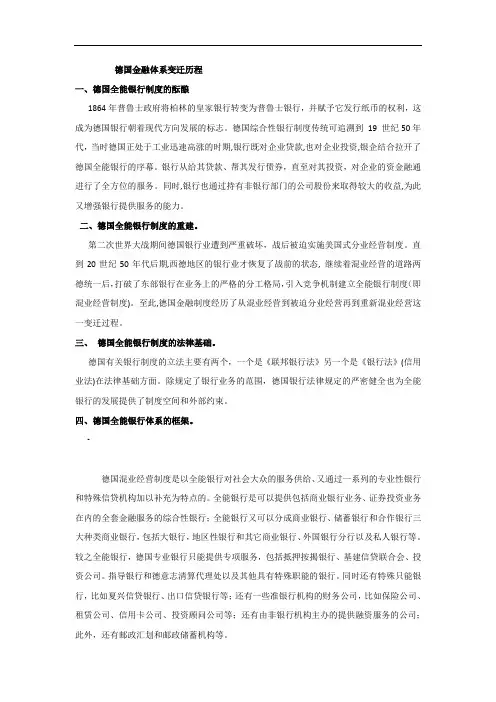
德国金融体系变迁历程一、德国全能银行制度的酝酿1864年普鲁士政府将柏林的皇家银行转变为普鲁士银行,并赋予它发行纸币的权利,这成为德国银行朝着现代方向发展的标志。
德国综合性银行制度传统可追溯到19 世纪50年代,当时德国正处于工业迅速高涨的时期,银行既对企业贷款,也对企业投资,银企结合拉开了德国全能银行的序幕。
银行从给其贷款、帮其发行债券,直至对其投资,对企业的资金融通进行了全方位的服务。
同时,银行也通过持有非银行部门的公司股份来取得较大的收益,为此又增强银行提供服务的能力。
二、德国全能银行制度的重建。
第二次世界大战期间德国银行业遭到严重破坏,战后被迫实施美国式分业经营制度。
直到20世纪50年代后期,西德地区的银行业才恢复了战前的状态, 继续着混业经营的道路两德统一后,打破了东部银行在业务上的严格的分工格局,引入竞争机制建立全能银行制度(即混业经营制度)。
至此,德国金融制度经历了从混业经营到被迫分业经营再到重新混业经营这一变迁过程。
三、德国全能银行制度的法律基础。
德国有关银行制度的立法主要有两个,一个是《联邦银行法》另一个是《银行法》(信用业法)在法律基础方面。
除规定了银行业务的范围,德国银行法律规定的严密健全也为全能银行的发展提供了制度空间和外部约束。
四、德国全能银行体系的框架。
-德国混业经营制度是以全能银行对社会大众的服务供给、又通过一系列的专业性银行和特殊信贷机构加以补充为特点的。
全能银行是可以提供包括商业银行业务、证券投资业务在内的全套金融服务的综合性银行;全能银行又可以分成商业银行、储蓄银行和合作银行三大种类商业银行,包括大银行,地区性银行和其它商业银行、外国银行分行以及私人银行等。
较之全能银行,德国专业银行只能提供专项服务,包括抵押按揭银行、基建信贷联合会、投资公司。
指导银行和德意志清算代理处以及其他具有特殊职能的银行。
同时还有特殊只能银行,比如夏兴信贷银行、出口信贷银行等;还有一些准银行机构的财务公司,比如保险公司、租赁公司、信用卡公司、投资顾问公司等;还有由非银行机构主办的提供融资服务的公司;此外,还有邮政汇划和邮政储蓄机构等。
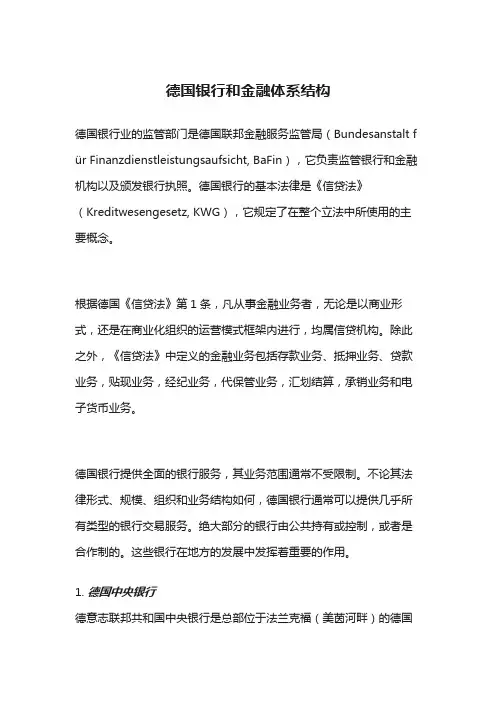
德国银行和金融体系结构德国银行业的监管部门是德国联邦金融服务监管局(Bundesanstalt f ür Finanzdienstleistungsaufsicht, BaFin),它负责监管银行和金融机构以及颁发银行执照。
德国银行的基本法律是《信贷法》(Kreditwesengesetz, KWG),它规定了在整个立法中所使用的主要概念。
根据德国《信贷法》第1条,凡从事金融业务者,无论是以商业形式,还是在商业化组织的运营模式框架内进行,均属信贷机构。
除此之外,《信贷法》中定义的金融业务包括存款业务、抵押业务、贷款业务,贴现业务,经纪业务,代保管业务,汇划结算,承销业务和电子货币业务。
德国银行提供全面的银行服务,其业务范围通常不受限制。
不论其法律形式、规模、组织和业务结构如何,德国银行通常可以提供几乎所有类型的银行交易服务。
绝大部分的银行由公共持有或控制,或者是合作制的。
这些银行在地方的发展中发挥着重要的作用。
1. 德国中央银行德意志联邦共和国中央银行是总部位于法兰克福(美茵河畔)的德国联邦银行。
德国中央银行的作用显著。
它的主要职责在于规制欧元体系的货币政策。
实际上,如在《欧共体条约》中规定的那样,德国中央银行的首要职责在于确保欧元区的物价稳定。
德国央行也协助防范国内和国际的金融危机。
在银行监管这个另一关键领域,德国中央银行协助执行的主要任务在于确保金融信贷制度健全,从而保证金融体系稳定。
连同其他央行功能,监管行为得以使中央银行对银行系统充分了解,尤其是其在资金市场、资本市场和货币市场上以及对信贷机构提供再融资上的作用,有利于确保金融市场的稳定(《欧共体条约》第105条第5款)。
作为与德国联邦金融服务监管局合作的内容,德国央行也负责检查德国约2300家信贷机构,评估其偿付能力、流动性和风险管理体系,包括审查银行业务,例如新巴塞尔资本协定的遵守,进行监管谈话,以及对通知和审计报告进行持续性评估。
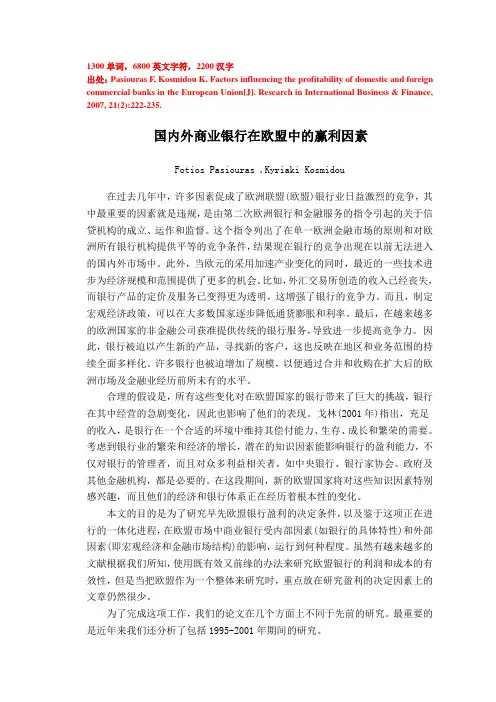
1300单词,6800英文字符,2200汉字出处:Pasiouras F, Kosmidou K. Factors influencing the profitability of domestic and foreign commercial banks in the European Union[J]. Research in International Business & Finance, 2007, 21(2):222-235.国内外商业银行在欧盟中的赢利因素Fotios Pasiouras ,Kyriaki Kosmidou在过去几年中,许多因素促成了欧洲联盟(欧盟)银行业日益激烈的竞争,其中最重要的因素就是违规,是由第二次欧洲银行和金融服务的指令引起的关于信贷机构的成立、运作和监督。
这个指令列出了在单一欧洲金融市场的原则和对欧洲所有银行机构提供平等的竞争条件,结果现在银行的竞争出现在以前无法进入的国内外市场中。
此外,当欧元的采用加速产业变化的同时,最近的一些技术进步为经济规模和范围提供了更多的机会。
比如,外汇交易所创造的收入已经丧失,而银行产品的定价及服务已变得更为透明,这增强了银行的竞争力。
而且,制定宏观经济政策,可以在大多数国家逐步降低通货膨胀和利率。
最后,在越来越多的欧洲国家的非金融公司获准提供传统的银行服务,导致进一步提高竞争力。
因此,银行被迫以产生新的产品,寻找新的客户,这也反映在地区和业务范围的持续全面多样化。
许多银行也被迫增加了规模,以便通过合并和收购在扩大后的欧洲市场及金融业经历前所未有的水平。
合理的假设是,所有这些变化对在欧盟国家的银行带来了巨大的挑战,银行在其中经营的急剧变化,因此也影响了他们的表现。
戈林(2001年)指出,充足的收入,是银行在一个合适的环境中维持其偿付能力、生存、成长和繁荣的需要。
考虑到银行业的繁荣和经济的增长,潜在的知识因素能影响银行的盈利能力,不仅对银行的管理者,而且对众多利益相关者,如中央银行、银行家协会、政府及其他金融机构,都是必要的。

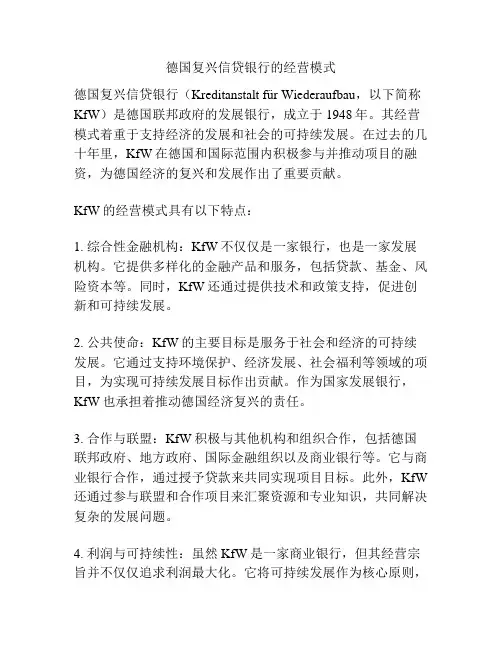
德国复兴信贷银行的经营模式德国复兴信贷银行(Kreditanstalt für Wiederaufbau,以下简称KfW)是德国联邦政府的发展银行,成立于1948年。
其经营模式着重于支持经济的发展和社会的可持续发展。
在过去的几十年里,KfW在德国和国际范围内积极参与并推动项目的融资,为德国经济的复兴和发展作出了重要贡献。
KfW的经营模式具有以下特点:1. 综合性金融机构:KfW不仅仅是一家银行,也是一家发展机构。
它提供多样化的金融产品和服务,包括贷款、基金、风险资本等。
同时,KfW还通过提供技术和政策支持,促进创新和可持续发展。
2. 公共使命:KfW的主要目标是服务于社会和经济的可持续发展。
它通过支持环境保护、经济发展、社会福利等领域的项目,为实现可持续发展目标作出贡献。
作为国家发展银行,KfW也承担着推动德国经济复兴的责任。
3. 合作与联盟:KfW积极与其他机构和组织合作,包括德国联邦政府、地方政府、国际金融组织以及商业银行等。
它与商业银行合作,通过授予贷款来共同实现项目目标。
此外,KfW 还通过参与联盟和合作项目来汇聚资源和专业知识,共同解决复杂的发展问题。
4. 利润与可持续性:虽然KfW是一家商业银行,但其经营宗旨并不仅仅追求利润最大化。
它将可持续发展作为核心原则,并确保其项目的经济、社会和环境可持续性。
在实施贷款项目时,KfW会进行严格的风险评估和可行性研究,确保项目的可行性和长期效益。
5. 国内和国际业务:KfW的业务不仅限于德国国内,也涉及国际范围。
在德国,KfW通过向中小企业、创新项目和新兴产业提供贷款和支持,促进经济的发展。
在国际范围内,KfW 通过与发展中国家和新兴市场合作,为这些地区的经济和社会发展提供贷款和支持。
总之,德国复兴信贷银行(KfW)的经营模式是以可持续发展为核心原则的综合性金融机构。
它通过提供多样化的金融产品和服务,支持经济的发展和社会的可持续发展。
作为德国联邦政府的发展银行,KfW承担着推动德国经济复兴和实现可持续发展目标的重要责任。

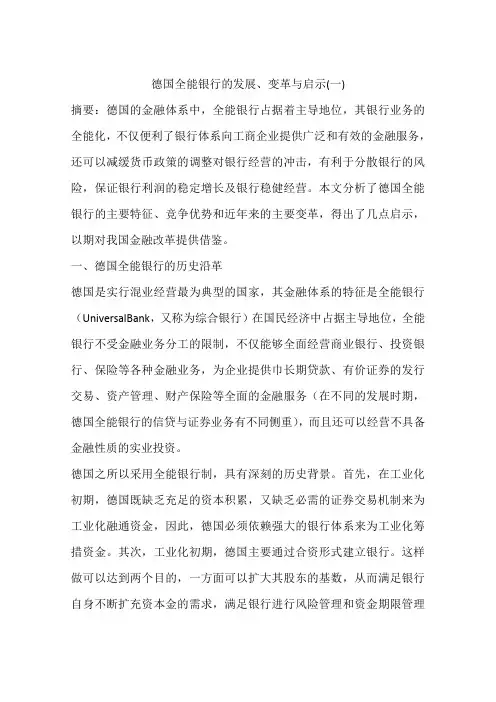
德国全能银行的发展、变革与启示(一)摘要:德国的金融体系中,全能银行占据着主导地位,其银行业务的全能化,不仅便利了银行体系向工商企业提供广泛和有效的金融服务,还可以减缓货币政策的调整对银行经营的冲击,有利于分散银行的风险,保证银行利润的稳定增长及银行稳健经营。
本文分析了德国全能银行的主要特征、竞争优势和近年来的主要变革,得出了几点启示,以期对我国金融改革提供借鉴。
一、德国全能银行的历史沿革德国是实行混业经营最为典型的国家,其金融体系的特征是全能银行(UniversalBank,又称为综合银行)在国民经济中占据主导地位,全能银行不受金融业务分工的限制,不仅能够全面经营商业银行、投资银行、保险等各种金融业务,为企业提供巾长期贷款、有价证券的发行交易、资产管理、财产保险等全面的金融服务(在不同的发展时期,德国全能银行的信贷与证券业务有不同侧重),而且还可以经营不具备金融性质的实业投资。
德国之所以采用全能银行制,具有深刻的历史背景。
首先,在工业化初期,德国既缺乏充足的资本积累,又缺乏必需的证券交易机制来为工业化融通资金,因此,德国必须依赖强大的银行体系来为工业化筹措资金。
其次,工业化初期,德国主要通过合资形式建立银行。
这样做可以达到两个目的,一方面可以扩大其股东的基数,从而满足银行自身不断扩充资本金的需求,满足银行进行风险管理和资金期限管理的需求;另一方面通过持有非银行部门的公司股份,当持有的公司公开上市后,银行可以取得较大的收益。
事实证明,在全能银行体制运作初期,德国的银行体系一直发挥着重要的作用,特别是在战后的重建时期,德国银行业以其高效率的运作,为国民经济的发展发挥了重要的作用。
根据德国《银行业务法》的规定,银行的经营范围包括存款、贷款、贴现、信托、投资、担保、保险、汇兑、财务代理、金融租赁等金融业务。
不仅涉足传统商业银行业务,还涉足投资银行业务。
在德国,零售业务的高成本和低盈利能力一直困扰各大银行,基于提高盈利能力的考虑,德国各大银行都将个人金融市场划分为两块:即拥有高额个人资产的“大客户”和一般小客户。
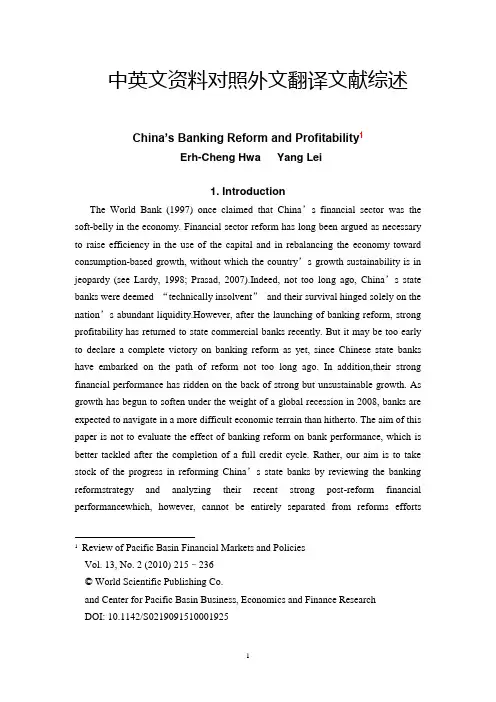
中英文资料对照外文翻译文献综述China’s Banking Reform and Profitability1Erh-Cheng Hwa Yang Lei1. IntroductionThe World Bank (1997) once claimed that China’s financial sector was the soft-belly in the economy. Financial sector reform has long been argued as necessary to raise efficiency in the use of the capital and in rebalancing the economy toward consumption-based growth, without which the country’s growth sustainability is in jeopardy (see Lardy, 1998; Prasad, 2007).Indeed, not too long ago, China’s state banks were deemed “technically insolvent”and their survival hinged solely on the nation’s abundant liquidity.However, after the launching of banking reform, strong profitability has returned to state commercial banks recently. But it may be too early to declare a complete victory on banking reform as yet, since Chinese state banks have embarked on the path of reform not too long ago. In addition,their strong financial performance has ridden on the back of strong but unsustainable growth. As growth has begun to soften under the weight of a global recession in 2008, banks are expected to navigate in a more difficult economic terrain than hitherto. The aim of this paper is not to evaluate the effect of banking reform on bank performance, which is better tackled after the completion of a full credit cycle. Rather, our aim is to take stock of the progress in reforming China’s state banks by reviewing the banking reformstrategy and analyzing their recent strong post-reform financial performancewhich, however, cannot be entirely separated from reforms efforts1Review of Pacific Basin Financial Markets and PoliciesVol. 13, No. 2 (2010) 215–236©World Scientific Publishing Co.and Center for Pacific Basin Business, Economics and Finance ResearchDOI: 10.1142/S0219091510001925undertaken thus far.This paper has three sections. In Section 2, we review the reform strategy of China’s large state banks, which is the main thrust of China’s banking reform, as well as its implementation. The Section 3 analyzes 2007 financial performance focusing on the four largest state commercial banks that have floated shares in the market: Industrial Commercial Bank of China (ICBC),China Construction Bank (CCB), Bank of China (BOC), and Bank of Communications (BOCOM). The conspicuous exception is Agriculture Bank of China (ABC), which is still in the process of restructuring for market listing at an appropriate time later. Section 4 concludes with an assessment on bank performance.2. Bank Reform Strategy and Its Implementation2.1. Bank reform strategyBefore reform, state banks were solely owned by the State and served national economic policy goals.1 Since they were not wholly profit-making commercial entities, common commercial banking criteria for evaluating their financial performance do not apply strictly. Nevertheless, as soon as the country decided to embark upon the path of a socialist market economy in the October 1992 CCP Congress, commercialization of the state banks had become a foregone conclusion. The goal of banking reform is to turn state banks into commercial entities that are competitive in the marketplace and can provide efficient intermediation of the nation’s saving. Given their dominance in financial intermediation, the banks play a crucial role in the efficient allocation of capital.2.1.1. Creating the enabling environment for banking reformThe country’s market reform and opening program has greatly accelerated since 1992 when in October that year the 14th CCP Congress declared that the goal of reform and opening was to create a socialist market economy,which effectively ended the experimental nature of economic reform and opening program launched since the late 1970s. The firming up of market-oriented reforms has created an enabling environment for a host of reforms central to the socialist market economy construct including foremost the banking reform. In early 1994, in response to the inflation threat, the government launched macroeconomic reform encompassing central banking,exchange rate management, and fiscal policy and taxation. The macroeconomic reform permitted the central authorities to regain macroeconomiccontrol lost to local authorities in the decade of the 1980s under the decentralization policy of “fang quan rang li”.2 While decentralization ushered a period of rapid growth, it also generated significant macroeconomic instability.Indeed, the pursuit of macroeconomic reform significantly dampened macroeconomic cycles in the 1990s. Second, in the same year, the government created three policy banks —State Development Bank, Agriculture Development Bank, China ExportImport Bank —to relieve state commercial banks of their traditional policy mandates.Third, the government promulgated central banking and commercial banking laws in 1995 to provide the legal foundation for banking reform.Fourth, beginning from 1996 the government began to vigorously pursuit enterprise reform that paved the way for banking reform, even this resulted in large and painful layoffs of redundant state workers. Pursuingenterprise reform ahead of banking reform was necessary considering that state-owned enterprises were the main clients of state banks and hence their main source of non-performing loans NPLs, which was at the same time the contingent liability to the government. Hence, unless the reform of stateowned enterprises takes hold, any reform effort of the state banks would be in vain. On the other hand, as soon as the state-owned enterprise reform was pressed forward, the banking reform could no longer be postponed. This is because as state-owned enterprises were restructured, liquidated, merged, or bankrupted out of existence, the banks must start to recognize the hidden losses on their books. This, in turn, triggered the need to recapitalize the banks, as a large amount of non-performing loan was written-off.Fifth, the State Council in February 2002 decided to reform solely stateowned commercial banks into internationally competitive financial enterprises, transform them into state-controlled shareholding commercial banks,and encourage listing their shares in the market.Sixth, China Banking Supervisory Committee was created in 2003 to raise the regulatory capacity to supervise banks. Finally, adhering to the 2001 WTO accession agreement, the government uses the entry of foreign banks into the local banking market to inject competitive pressure to the local banking industry in order to gain efficiency. Beginning from the end of 2006, foreign banks can engage in local currency business.2.1.2. Reforming corporate governance and restructuringthe balance sheetThe country’s large state banks have followed several steps to undertake internal corporate reform. The first is to reform the corporate governance by inviting other investors to dilute the sole state ownership while still retaining its dominance. In particular, the banks have made an effort to seek foreign strategic partnership with the view to bringing in modern banking practices and technology. The broadening of ownership also entails selling a portion of bank shares to the equity market to make bank management accountable to the marketplace. To successfully woo outside investors, be it strategic partners or public investors, the banks must put forward a creditable inhouse reform plan and implement it credibly. No doubt, the better and more credible the internal reform plan is, the more likely it is for the banks to attract reputable outside partners and fetch a better deal with their counterparts or in the equity market.Hence, the first step the government undertook was to strengthen the balance sheet of state banks whose credit flows had been clogged up by inadequate capital and piles of bad debts accumulated under the previous economic planning regime. In 1998, the government issued RMB270 billion (US$32.6 billion) worth of 30-year fiscal bonds to recapitalize the balance sheets of the four largest state banks: ICBC, BOC, CCB, and ABC in order to comply with the international capital adequacy standards. Again, on December 30, 2003, the government provided US$22.5 billion each to CCB and BOC, with US$15 billion provided later in April 2005 to ICBC to support their respective listings in the Hong Kong stock exchange.Among the four largest state banks, CCB was the first to have its shares successfully listed in the Hong Kong stock exchange and thus the first to have its reform effort passed by the market test. In addition, as part of the scheme of recapitalization, the banks also issued subordinated debt to the local market:BOC, RMB60 billion; CCB, RMB40 billion; ICBC, RMB35 billion; and BOCOM, RMB12 billon.In 1999, the government created four asset management corporations AMCs, one for each of the “big four”: ICBC, CCB, BOC, and ABC, to manage RMB1.4 trillion of loans purchased from the books of the state banks at face value, of which 1.3 trillion were deemed non-performing (about 15% of GDP). The transaction was financed partly by central bank loan(RMB573 billion) and partly by treasury bonds (RMB820 billion). A second transferring of NPLs in the amount of RMB1.186 trillionto the AMCs took place during the period from June 2004 through June 2006.The banks also launched reform measures to improve internal management including strengthening the human resource base, introducing modern risk management practices, and moving up the standard of NPL classification to comply with the international standards.2.2. Implementation of reform2.2.1. Seeking diversification and attracting foreign strategic partners Following the blueprint of reform, the banks have successfully launched and implemented the reform strategy. ICBC, CCB, BOC, and BOCOM all have their full state stake in the company diluted to below 70% by incorporating non-state ownerships, which includes foreign ownership, domestic legal persons, and public ownership (publicly owned and traded shares). Among non-state owners, foreign strategic partnership usually has the highest stake in the company: ICBC, 7.2%, BOC, 13.9%, CCB, 10.3%, and BOCOM,18.7% (Table 1).The participation of foreign and domestic capital as well as public shares in state commercial banks has not only strengthened bank capital, but also exerted a positive influence on the corporate governance, in particular in the case of foreign participation, in so far as it stems the undue intrusion of government into the banking business. Second, all state commercial banks have installed modern corporate governance structure encompassing shareholders congress, corporate board plus outside directors and supervisors,supervisory board, and senior management structure. By the end of 2007, 33 foreign institutional investors have invested in twenty-five domestic banks, with a total capital injection of US$21.3 billion.These foreign strategic investors have entered in various strategic corporative agreements with domestic partners in widely diversified areas of banking,including retail banking, corporate governance and risk-management,trading, RMB derivatives and currency swaps, foreign exchange structured products, and trade and small-and-medium enterprises SME financing. In addition, domestic banks and their foreign partners share their networks and custom base for providing services and cross-selling financial products.Finally, human resource development program is a common feature in strategic corporative agreements, with training courses offered in SME management and financing, wealth management, fund trading, risk management, and implementation of the Basel Capital Agreements, etc.2.2.2. Successful public listingsAfter launching internal restructuring and successful attraction of reputable foreign strategic partners, state commercial banks were successful in listing their shares in the Hong Kong (H share) and Shanghai (A share) stock exchanges and hence for the first time subject to the market discipline:BOCOM, June 2005; CCB, October 2005; BOC, June 2006; ICBC, October 2006 (which was the first double listing in both the Hong Kong stock exchange and the Shanghai stock exchange). Public listing of bank shares together raised RMB445 billion (US$60 billion) in the open market, about 26% of combined net capital. In comparison, the funds raised through foreign strategic partners was US$15 billion. In 2007, two small shareholding banks were listed in the Shanghai stock exchange, bringing the total listed to seven among 12 shareholding banks. In addition, three city commercial banks based, respectively, in Beijing, Nanjing, and Ningbo were listed in the Shanghai A share market, paving the way for other city commercial banks to restructure and then seek listing in the stock exchange. Having benefited from rising share prices, ICBC, CCB, and BOC were, respectively, the first,second, and the fourth largest bank in the world by market capitalization at the end of 2007: US$338.9 billion, US$2202.5 billion, and US$197.8 billion.2.2.3. Strengthening capitalBy the end of 2007, nearly 80% of banks by asset have fulfilled capital adequacy standards. The capital adequacy ratio for the four listed state commercial banks was, respectively, 13% for ICBC; 13.3% for BOC; 12.6% for CCB; and 14.1 for BOCOM. The core capital adequacy ratio was, respectively, 11% for ICBC; 10.7% for BOC;10.4% for CCB; and 10.2% for BOCOM.2.2.4. Building risk management systemsSince 2006 CCB and other large state commercial banks have begun to introduce a vertical risk management system to consolidate risk management into the hands of the newly created chief risk officer. The reform has helped to stem undue interferences in the loan decision process at the local level. At the same time, by taking advantage of information technology, banks have begun to streamline and optimize the operational processes and procedures in order to reduce operational risks. Banks have also begun to use quantitative risk models to gauge and simulate various risk scenarios facing them such as stress test. The concept of economic/risk capital has been adopted to manage risk quotas, allocate bank resources, and pricing of products. Banks have alsostrengthened the analysis of market and liquidity risks while controlling operational risks through improved internal control procedures by employing quantitative tools and models. Last but not least, banks have taken steps to build a new risk or credit culture.2.2.5. Pursuing strategic transformation of the business modelChinese banks have traditionally focused on corporate businesses, the wholesale banking so to speak. However, as the local capital market gradually matures and the income and wealth of Chinese households continue to grow apace, the banks find growing business opportunities in consumer-oriented financial services such as mutual funds, mortgage financing, wealth management, and personal loans. These are also areas of financial services where the newly arrived foreign banks aim to capture with their competitive strength.Hence, both for seeking new sources of profit growth and achieving a more diversified and balanced revenue base, as well as for meeting the competition from foreign banks head on, the Chinese banks are compelled to seize the opportunity and meet the challenge to embark on the path of a strategic transformation of the traditional business model toward retailing banking.New thrusts of retail banking include credit card, personal loans, and wealth management, mutual fund, insurance products and other products generating fee-based income. Retail banking, in turn, has called for greater investment in information technology to develop efficient systems in processing personal loan, internet banking, and tele-banking, as well as improve the efficiency of retail networks to better serve the needs of retail rge state commercial banks like CCB have also initiated special programs to cater to the need of small and medium enterprises, SMEs. In addition, they have started to branch out into new areas of financial services, thus gradually and steadily moving toward universal banking encompassing investment banking, issuance, securities, private banking, and financial leasing.Banks have also started to grow overseas business either by establishing more new overseas branches or through merging and acquisitions of foreign financial entities.4. Conclusion: Assessment of Bank PerformanceThe strong financial performance of large state banks was carried into the first half of 2008 even as growth slowed by nearly 2 percentage points to 10.4% from the firsthalf of 2007 due to a combination of falling external demand and tighter credit policy. In the first half of 2008, net profit (profit after tax) grew, respectively, 71.3% for CCB, 56.8% for ICBC, and 36% for BOC over a year ago. Although the reduction of corporate income tax from 33% to 25% accounted for partly the increase in profit, but the key underlying factors driving profit growth remained the same as the last year. First,net interest income continued to benefit from rising interest margins as well as rapid asset growth and still is the main source of operating income, possibly for the foreseeable future. Second, fee and commission income again witnessed an explosive growth: CCB, 59.3%; BOCOM, 50%, ICBC, 48%;BOC, 45.1%, in spite of a sharply cooled stock market that has curtailed income derived from hot-selling market-based financial products of the previous year such as stock mutual funds. For large state commercial banks,the share of fee and commission income in total operating income reached a new record in the first half of 2008: CCB 14.9%; ICBC, 12.3%; BOC,31.4%. In the meantime, asset quality continued to improve as the NPL ratio continued to drop. By the end of June, the NPL ratio of ICBC and CCB were, respectively, 2.4% and 2.2%, representing a decline of 0.33 and 0.39 percentage points, respectively, from the end of 2007.Judged by record profit, much improved asset quality, and high ROE,the recent financial performance of the four large state commercial banks is nothing short of spectacular. Furthermore, as fee and commission income and more broadly retail banking revenue has taken off to become a strong source of profit growth, banks appear on track to realize their long-term strategic goal of diversifying into a more stable base of income generation that is less prone to business cycle risks. Thus, large state commercial banks appear to have come a long way in reforming themselves into a modern commercial bank. This outcome should be a surprise to some of earlier research findings that argue state commercial banks did not seem to have changed bank behavior fundamentally after launching banking reform. For instance,Podpiera (2006) shows that banks do not appear to make lending decision based on a commercial basis. Dobson and Kashyap (2006) assemble macroeconomic, microeconomic and anecdotal evidence suggesting that the pressure to make policy loans is continuing despite the reforms. However, the recent empirical work by Demetriades et al. (2008) seems to counter their findings by showing that bank loans is positively correlated with future value added and TFP growth during 1999–2005,even for state-owned enterprises. Moreover they find that firms with access to bank loans tend to grow faster in regions with greater banking sector development.Can this financial performance of banks be sustained? It appears that the good financial performance has been the result of two crucial factors,although it is not easy to delineate the two. First, a supportive macroeconomic environment —with a strong growth averaging 10.7% per annum over the period: 2003–2007 and a partially liberalized interest rate regime —helped to boost revenues. Second, banking reform has been instrumental in raising efficiency and holding down costs, both of which boost the return on capital.Compared to the impact of banking reform, the supportive macroeconomic environment exerts more a cyclical than fundamental impact on bank performance and is thus a less sustainable force. Indeed, the surging inflation as well as bubbles in the stock and real estate markets in 2007 already served as warning signals that the high growth in last several years is unsustainable. In 2008, the economic growth slowed sharply as a result of tightened money and credit policy and an unexpected large decline in external demand that sharply slowed down export growth. Although bank performance held up pretty well so far, a precipitous economic slowdown would sooner or later raise business risks and worsen asset quality for the banks. The immediate challenge of banks is how to skillfully navigate the more difficult economic water by properly controlling risks and staying on the course of restructuring and reform.If the successful public listing marked the end of the first phase of banking reform, it is clear that banks have entered a new phase of reform only a short while ago with much of the journey still lying ahead. Many of the recently launched corporate reforms: governance, internal control and operation procedures, risk management, and human resources are still work in progress and have not yet been brought to fruition. Banks are also in the early phase in adapting to the new business model mandating more attention being paid to retail customers and commission and fee-based incomes. Hence, they have to continue to be valiant on reform and learn to adapt to the vagaries of financial markets while catering to the evolving needs of customers as their demand for new financial services grow.While putting the bet on banking reform, there is no reason to be overly pessimistic on the short-term macroeconomic risks. China ran a budget surplus and had a lowgovernment debt of about 22% of GDP in 2007, as well as a relatively low urbanization ratio at around 44%. More importantly, Chinese banks have embarked on a reform path with healthy balance sheets and a strong capital base. Thus, China enjoys considerable flexibility to deploy a strong public sector investment program in order to strengthen domestic demand and mitigate the downside risks caused by the expected sharp decline in exports. The government unveiled such a public sector investment program with price tag of RMB4 trillion in mid-November 2008 (about 12% of GDP) that covered two years to last through 2010. The program complimented the expansionary money and credit policy that had been initiated a couple of months ago. If properly implemented and, in particular, in conjunction with structural rebalancing policies, the program should help to sustain strong growth in the short-run and even more important to regain macroeconomic balance over the medium-term.中国银行业的改革和盈利能力1概述世界银行(1997年)曾声称,中国的金融业是其经济的软肋。
外文文献翻译原文及译文(节选重点翻译)美国商业和储蓄银行的盈利能力,资本和风险外文文献翻译中英文文献出处:The Quarterly Review of Economics and Finance, Volume 74, November 2019, Pages 148-162译文字数:4800 多字英文Profitability, capital, and risk in US commercial and savings banks: Re-examination of estimation methodsJacob Paroush,Ben SchreiberAbstractThis study compares the relationships between the three main bank variables i.e., profitability, capital, and risk of US commercial and savings banks for the period 1995Q1-2015Q4. As the literature analyzes the relationship between these variables in pairs, thus suffering from an 'omitted variable bias' and a 'simultaneous equations bias', we examine whether these biases are statistically significant. We compare the common methodology of a three two-equation system with both a three- equation system and three separate OLS regressions. While there are significant differences in the coefficients of the three main variables within the sample period, we could not find substantial differences in out- of-sample forecast estimates.Keywords:Profitability,Capital,Risk,Commercialbanks,Savings banks,Simultaneous equations bias,Omitted variable biasIntroductionThe three main variables that characterize banks are capital, profitability, and risk. However, they are usually examined in pairs i.e.,profitability and capital, profitability and risk, and capital and risk. Such analyses are, however, only partial and the empirical results may be ambiguous. For example, regulatory bodies tend to focus on risk and capital held against unexpected losses. Thus, if one bank is characterized by high profitability compared to another bank (all other things being equal), an identical assessment of the two banks may be misleading. On the other hand, investors usually consider profitability and risk more than capital.1 Disregarding capital may lead to a bias assessment, if the amount of capital of one bank is large while that of another bank is small (all other things being equal). Thus, the empirical estimates of regression coefficients in pairs may suffer from specification errors in the case of omitting variables or from the 'simultaneous equations bias' in the case of omitting the third equation.The relationship between capital, profitability and risk may be different for commercial, savings banks, or other bank types. For example, some studies argue that differences between bank types regarding the above three main variables reflect inefficiency, inaccessibility to capital markets or capital adjustment costs, persistency in profitability, different regulatory environments, or limited competition in the savings banks industry.The aim of this study is, therefore, to examine whether a complete statistical modelling of the three main variables yields differentcoefficients compared to the common practice where the three main variables are examined in pairs, thus suffering from both simultaneous equations and omitted variable biases. We examine these two different bank types since they are characterized by different levels of profitability, risk and to a lesser extent, capital and they react differently to shocks.2 Thus, the coefficient differences between the two bank types can be the result of either their different characteristics or the different estimation method used.The contribution of this study is a comparison of the regression coefficients of the three main variables by three separate OLS regressions, by three two-equation systems (profitability and capital, profitability and risk, and capital and risk), and by one three-equation system of the three main variables for US commercial and savings banks. The three estimation methods are examined both in-sample and out-of-sample.The study relates to the empirical literature that examines the relationship between capital, profitability, and risk in pairs. However, to the best of our knowledge, this is the first study that compares various statistical methods used in the literature to assess profitability, capital, and risk in US banks. The results uncover different coefficients of the three main variables with regard to the estimation method used but similar accuracy measures in out-of-sample forecasts.Literature surveyThis section surveys the literature regarding the relationship between each pair of the variables: profitability, capital, and risk. Table summarizes the evidence concerning these three main variables in commercial and savings banks.Generally, the evidence is ambiguous concerning the relationships between the three main variables across bank types, countries, and estimation techniques. This evidence corroborates our choice to examine the relations for more than one bank type.The relationship between profitability and capitalBarth, Groper, and Jahera (1998) argue that the Capital Asset Ratio (hereafter CAR) is negatively correlated with Return On Assets (hereafter ROA) and Return On equity Capital (hereafter ROC). The negative relationship is obtained, ceteris paribus, in a one-period model where deposit rates are not influenced by bank risk i.e., there is no 'market discipline'. However, if the cost of funding is influenced by the capital level, a positive relationship between capital and profitability is expected as capitalized banks reduce their costs of funding, which in turn increases their profits (see also Berger, 1995). According to the Signaling Hypothesis (see Acharya, 1988), managers have 'inside information' regarding future performance. If their compensation packages include stocks and/or stock options, it will be cheaper for a safe bank than for a risky bank to signal expected improved performance in the future byincreasing capital today. Therefore, CAR entails ROC. Stiroh (2000) provides another argument for this causation. When banks increase their capital levels in order to overcome high entry barriers, they gain access to profitable activities such as issuing guarantees and subordinated notes, as well as acting as intermediators in derivative markets. In contrast to the above causation, Rime (2001) finds that earnings of Swiss banks have positive impact on capital through retained earnings, thus ROC entails CAR. However, Berger, DeYoung, Flannery, Lee, and Öztekin (2008) find for large US banks that the relationship between ROC and CAR is insignificant. Examining various European bank types, Goddard, Molyneux, and Wilson (2004) and Stolz and Wedow (2011) find a positive relationship between capital and profitability in commercial banks whilst finding a negative relationship in savings banks. Finally, Altunbas et al. (2007) report on a positive relationship between capital and profitability for both European commercial and savings banks. Such evidence is also found by Bitar, Pukthuanthong, and Walker (2018) for banks in OECD countries.The ambiguous evidence regarding the relationship between capital and profitability points to the lack of either a relevant theory or a common expectation that makes it difficult to establish hypotheses regarding this relationship and its factors.The relationship between capital and riskA negative relationship between capital and risk is expected when all deposits are insured with a flat premium rate (Osterberg & Thomson, 1989). In this case, the marginal cost of increasing bank risk and/or reducing the level of capital is zero. This is because in the view of the regulators, the insurance premium does not change with risk or capital while for the insured depositors the interest demanded on their deposits is the same as that on a riskless asset. On the other hand, when the insurance premium is adjusted for risk e.g., including the level of financial leverage, there is less incentive to change the financial leverage. The 'optimum capital buffer theory' suggests that banks have an incentive to hold more capital than required as insurance against a violation of the regulatory minimum capital requirements (Heid, Porath, & Stolz, 2004; Stolz & Wedow, 2011). This is the result of banks' inability to adjust capital and risk instantaneously and the fear of costly supervisory action or a loss of reputation by banks' stakeholders. Hence, banks with relatively large capital buffers are supposed to maintain their capital buffers despite the risk increasing or may increase both capital and risk while banks with small capital buffers aim at rebuilding an appropriate capital buffer (increase capital and decrease risk). Alfon, Argimon, and Bascunana- Ambr (2004) find a negative relationship between capital and risk in U.K. banks. They suggest several explanations for the actual capital levels, which are substantially higher than the regulatory requirements (seealso Berger et al, 2008). Altunbas et al. (2007) find a positive relationship by commercial European banks while a negative relationship is found among savings European banks. Such a negative relationship is also found by Van Roy (2005) regarding US banks and by Lee and Hsieh (2013) concerning commercial and cooperative Asian banks, Lately, Bitar et al. (2018) found that risk-based capital ratios have no impact on bank risks. Flannery and Rangan (2008) explain the capital build-up of US banks during the 90 s by higher risk levels (among other reasons). Cebenoyan and Strahan (2004) find that banks which used the loan sales market for risk management purposes held less capital and were more profitable but riskier than other banks. In contrast, Shrieves and Dahl (1992) and Rime (2001) find a non-negative relationship between capital and risk. Moreover, Jokipii and Milne (2011) report on a positive relationship between capital buffers and risk and that the adjustment pace is dependent on the degree of bank capitalization (see also Berger et al., 2008). Notice that similar to the relationship between capital and profitability the results regarding capital and risk are ambiguous, as well.The relationship between risk and profitabilityIn a competitive business environment where symmetrical information between the bank and its borrowers prevails, one can expect (ex-ante) a positive relationship between profitability and risk. Thisshould be the result of the risk premium demanded by a bank from its borrowers and by the bank stakeholders (See also Saunders, Strock, & Travlos, 1990; Shrieves & Dahl, 1992). However, realized (ex-post) risk should harm profitability thus, a negative relationship between profitability and risk, is usually evidenced (see Athanasoglou, Brissimis, & Delis, 2008; Stolz & Wedow, 2011). This relationship is examined in particular across the business cycle. For example, Athanasoglou et al. (2008) find a significant negative relationship between ROA and credit risk for Greek banks during the period 1985–2001, regardless of the business cycle phase. In contrast, Bolt, de Haan, Hoeberichts, van Oordt, and Swank (2012) find for OECD banks during the period 1979–2007 that bank profitability behaved pro-cyclically. The co-movement was especially strong during severe recessions, and it was mainly due to credit risk. Finally, Tan (2016) finds neither positive nor negative relations for Chinese banks during the period 2003-2011.The evidence so far concerning the relationships between profitability, capital, and risk reflect indecisive relations thus, room for further empirical examination of different periods, bank types, and geographical areas.3. The data and estimation resultsThis section describes the data used in this study and the estimates of the various statistical methods.The database consists of US commercial and savings banks under the supervision of the FDIC (5338 and 844 institutions, respectively in 2015Q4) for the period 1995Q1–2015Q4 (84 quarters). All banks are insured by the Federal Deposit Insurance Corporation (FDIC) either through the Bank Insurance Fund (BIF) or through the Savings Association Insurance Fund (SAIF). Commercial banks include national banks and depository trust companies while the savings banking category includes savings banks and savings and loan institutions supervised by the Office of Thrift Supervision (OTS). The quarterly data of banks are obtained from the FDIC's web site, based on Quarterly Call Reports of all commercial and savings banks. This means that our sample data reflect the entire US banking system rather than particular banks. The advantage of the database is its reliability, consistency, and the lack of sample biases as it contains all insured US banks.The figure clearly presents differing behavior between the two bank types and across the sample period. Generally, by the Bai and Perron procedure there are three sub periods: before, at, and after the great financial crisis. The first sub period (1995Q1-2007Q4, hereafter expansion period) is characterized by high ROA and relatively low PROV. The second sub period (2008Q1-2009Q2, hereafter contraction period) reflects the great financial crisis and its consequences i.e., high PROV and decreasing of both ROA and CAR. The third sub period(2009Q3-2015Q4) reflects a recovery from the crisis yet, to lower levels of ROA and PROV. During the expansion period, the ROA (PROV) is much larger (smaller) than that of the contraction period as expected, while CAR is modestly higher during the contraction period (from 9.0% to 9.8% in commercial banks and from 9.3% to 10.3% in savings banks). The differing development of CAR versus both ROA and PROV is mainly explained by the Basel (I and II) and the TARP (Troubled Assets Relief Program) regulatory measures that positively affected banks' capital across the sample period (see Flannery & Rangan, 2008; Lee & Hsieh, 2013). Thus, one can notice substantial and different changes across the sample period concerning the three main variables between the two bank types. In what follows, we test the differentials between capital, profitability, and risk of US commercial and savings banks using Eq(4).ConclusionsThis study examines the relations between the three main variables of any financial institution i.e., capital, profitability, and risk. The common methodology in the literature analyzes the three main variables in pairs (two-equation system) namely, capital and profitability, capital and risk, and profitability and risk. Thus, it suffers from both the 'simultaneous equations bias' and the 'omitted variable bias'. As there is no relevant theory regarding the trilateral relationship among the three main variables and bank types, we examine whether these biases arestatistically significant by comparing the common methodology results with both: a complete simultaneous analysis of the above three variables in a three-equation system and with three different OLS regressions run on the main variables, separately. The comparison is done for both in- sample and out-of-sample periods. The data, which include all insured US commercial and savings banks for the period 1995Q1 – 2015Q4, reveal substantial differences between commercial and savings banks' coefficients. We find that changes in profitability (ΔROA) and in capital (ΔCAR) are positively related, changes in profitability (ΔROA) and in risk (ΔPROV) are negatively related, and changes in capital (ΔCA R) and in risk (ΔPROV) are mostly negatively correlated. While other studies often find differences in the coefficients' signs between commercial and savings banks, we find identical signs but significant differences in magnitude. These significant differences foster our argument that the 'simultaneous equations bias' and the 'omitted variables bias', are of importance in examining the in-sample relations between the three main variables. In contrast, the three-equation system does not outperform the other two methods in terms of goodness of fit or forecast capabilities.译文美国商业和储蓄银行的盈利能力,资本和风险:重新评估雅各布·帕鲁什,本·施莱伯摘要本研究比较了1995 年第一季度到2015 年第四季度期间三个主要银行变量之间的关系,即盈利能力,资本和美国商业和储蓄银行的风险。
德国产业融资模式德国产业融资模式介绍:德国是一个以制造业为主的经济体,其产业融资模式是建立在政府、银行和企业三者之间的紧密合作基础上的。
这种模式被称为“德国模式”,它的特点是银行贷款和股权融资并重,政府对中小企业提供补贴和税收优惠,企业注重长期发展。
一、银行贷款1. 德国银行体系概述德国银行体系由三个层次构成:中央银行、商业银行和合作银行。
中央银行是德意志联邦银行(Bundesbank),它主要负责货币政策。
商业银行包括私人商业银行、公共商业银行和邮政储蓄银行等,它们向企业提供贷款。
合作银行则主要服务于农村地区。
2. 银团贷款在德国,大型企业通常会选择与多家商业银团合作进行融资。
这种方式可以分散风险,同时也能够得到更多的信贷额度。
3. 长期信贷德国的银行通常会提供长期信贷,这种信贷的期限可以长达10年以上。
这种方式可以帮助企业实现长期发展计划。
二、股权融资1. 德国股票市场概述德国股票市场由两个交易所构成:法兰克福证券交易所和斯图加特证券交易所。
其中,法兰克福证券交易所是欧洲最大的证券交易所之一。
2. 德国中小企业股权市场(Mittelstandsbörse)德国中小企业股权市场是一个专门为中小企业提供融资服务的平台。
该平台由德国联邦政府和各地政府共同支持,旨在为中小企业提供更多的融资机会。
三、政府补贴和税收优惠1. 政府补贴德国政府鼓励企业进行研发和创新活动,因此会向符合条件的企业提供补贴。
此外,政府还会向一些特定行业的企业提供补贴,例如环保行业、能源行业等。
2. 税收优惠德国政府为了鼓励中小企业的发展,对这些企业提供了一系列的税收优惠政策。
例如,中小企业可以享受较低的企业所得税率,同时还可以获得一些减免税的机会。
四、德国模式的优势和不足1. 优势德国模式的最大优势在于它能够为企业提供长期稳定的融资支持,这有利于企业实现长期发展计划。
此外,政府和银行之间的紧密合作也有利于保持经济稳定和增长。
1外文资料翻译译文欧盟国内外银行盈利能力影响因素分析摘要:本文使用银行级数据,通过1995 - 2001年期间国内和外国银行在15个欧盟国家的商业运营情况来了解银行的具体特点和整体银行业环境对影响盈利能力。
结果表明, 国内和外国银行的盈利能力不仅受银行具体特点的影响,也受金融市场结构和宏观经济条件的影响。
除了在集中情况下国内银行利润,所有的变量都是有重大意义的,尽管它们的影响和关系对国内和国外银行并不总是相同.1 介绍在过去的几年许多的因素造成了欧盟银行业竞争日益激烈。
最重要的因素之一是针对服务、建立、运行和监督信贷机构的第二个欧洲指令出台,在银行和金融领域放松管制.这个指令为所有欧洲银行机构在单一欧洲金融市场和提供了平等的竞争条件,因此银行正在先前无法预料的国内外竞争之中。
另外, 最近一些的技术进步对规模经济和范围提供了更多的机会,而采用欧元也加速了行业的变化。
此外,宏观经济政策后大多数国家通货膨胀率和利率逐步降低。
最后,在越来越多的欧洲国家非金融公司被允许提供传统的银行服务,并且在竞争中进一步提高,银行被迫产生新的产品和寻找新客户.许多银行为了参加欧洲市场和银行业扩大被迫增加规模,通过合并和收购的方式进行了前所未有的整合。
在环境快速变化的情况下,这些变化给在欧盟的银行带来很大的挑战,因此影响了他们的效能。
格林指出,充足的收益是必要的条件让银行保持偿付能力,在一个合适的环境生存、发展和繁荣。
考虑到银行业的健康发展和经济知识增长,影响银行的盈利能力的潜在因素不仅和管理者有关,而且和众多利益相关者如中央银行,银行家协会、政府以及其他金融当局有关。
2 文献综述参考文献与本文可分为三大类。
第一部分是研究集中于银行的盈利能力的决定因素.第二部分包括研究欧洲银行的利润和成本效率。
第三由研究比较国内外银行。
在下面几个部分中,我们讨论这些类别中的每一个.3 决定因素和变量选择3.1 因变量本研究使用平均资产回报率(ROAA)来评估银行的性能。
德国银行职能及公司治理结构的转变作者:Ulrich SchrÖder and Alexander Schrader 访问次数:更新日期:2006-10-6 1:53:00 来源:奥尔多一、德国银行在公司治理中的作用:持股德国银行在公司治理中的职能曾经是许多有争议话题的焦点。
直到90年代初,其银行与公司部门的关系依然被公认为一个积极有利的因素,确保了许多长期贷款合同(long-termism);另一方面,在英美国家,我们看到的是八十年代发生的有过分敌意的收购战。
1990年的春天,经济学家杂志甚至建议说:“从传统的英美资本主义向更接近德国模式的资本主义转变”可以改善经济运行状况。
令人吃惊的是,在过去的短短几年中,人的观点和认识有如此大的变化。
仅仅在六年后,经济学家杂志断言:八十年代,日本和德国的利益相关者经济(stakeholder economies)存在许多的弊端,如德国经济缺乏灵活性和创造力……为了理解公司治理中银行职能的本质,应该把德国﹑美国和英国的金融系统放在一起对照比较(见表1)。
在美国和英国,证券市场发挥着极为重要的作用。
这两个国家的市场资本化(以占国内生产总值GDP 的百分比表示)程度高,公开上市的公司众多,并且每年还有大量的公司申请上市;机构投资者(包括保险公司﹑养老基金和共同基金)所持的股票比例约占流通中股票总数的一半或更多;会计准则向小投资者倾斜;公司治理主要依靠“控制公司的市场”。
表1、金融系统的对比美国英国德国流通中的债券(10亿美元)其中中央政府债券全部债券占GDP的百分比(%)上市的国内公司数量(家)股票市场值以10亿美元为单位占GDP的百分比(%)国内市场首次公开发行股票(IPOs.)机构投资者持股的比例(%)1销售净利润率(%)2负债权益比(面值)(%)1会计准则公司治理公司的债务筹资职业养老金计划8,837.34,952.61227,4406,994.997621463.01.04对投资者“真实与公允”“外部人机制”,市场的外部控制债券和可转换债券(CP)540.9361.4491,9711,391.2126285615.81.04(1985)与美国相同与美国相同大部分为短期债券养老基金2,282.9794.195678576.62420151.31.57审慎原则“内部人机制”,监事会大部分为长期银行银行系统超过50%养老基金投资与商业全能银行主导贷款主要为账面储备金全能银行1.为1993年数字;2.制造业:1990—1994年的平均值。
外文翻译原文German bank capital model structure and profitability of changeMaterial Source: R&D Management34,4,2004Author: Lars Norden and Martin WeberWe investigate the funding modes of German banks and the implications for lending and profitability during 1992–2002. We find that at many banks, deposits from customers decrease in relative terms while interbank liabilities increase as a source of funding. We cannot detect a negative impact of the relative decline in deposits on lending. The decreasing ability of banks to collect deposits and the substitution of deposits by interbank liabilities unfavorably affects the net interest result of banks that exhibit a deposit deficit, especially savings banks. Our findings indicate a structural lengthening of the intermediation chain, which has broader implications for the functioning and stability of the financial system.In this paper, we investigate the structural changes in banks’ funding modes and the implications for lending to customers and the effect on bank profitability. Our empirical evidence is based on a micro data set for all German banks that we obtain from the Deutsche Bundesbank for the period 1992–2002.First, we find that growth of interbank liabilities is negatively related to the growth of deposits from customers at savings banks and credit cooperatives. The effect is strongest at savings banks. Thus, we provide empirical evidence for a structural change on the liability side of these banks’ balance sheets. This finding indicates an increasing specialization of retail and wholesale banks in the same sector, and it is consistent with an overall lengthening of the intermediation chain and with financial deepening of the economy. Banks facing a funding deficit become net interbank borrowers, while others that benefit from a stable funding surplus become net interbank lenders.Second, we do not detect a negative impact of the relative decline in deposits on lending to customers. Instead, lending slightly gains in relative importance over time.Third, the decreasing ability of banks to collect deposits from customers andthe substitution of deposits by interbank liabilities represents one explanation for the declining net interest result for German savings banks and other retail banks with a funding deficit. The implications of our analysis are first, that the example of Germany supports the view that the function of deposits matters. On the one hand, following demand-side arguments, checking accounts are unlikely to be affected by the structural change because these products are unique means of payment. Demand deposits are provided exclusively by banks and represent a significant feature of banks’ specialness. Supply-side arguments suggest that demand deposits and checking accounts provide banks with proprietary information that can be used for monitoring borrowers. Consequently, there are liquidity and informational synergies between deposit taking and lending. On the other hand, banks, non-bank financial intermediaries, and financial markets also offer financial products with an investment function. Our data indicate that savings deposits steadily decrease in relative importance, which leads to structural changes in bank funding modes and to a lengthening of the intermediation chain for investment products. Second, given the relative change of funding structures and the simultaneous growth in lending, there is a strategic need for alternative funding modes for retail banks. Relying on demand deposits is clearly not sufficient in the long run, and wholesale funding has its own limitations, as illustrated by the market freeze during the financial crisis of 2007–2009. More flexible rules for bond and commercial paper issuances, as well as asset securitization, might be ways to deal with strategic imbalances between the lending and deposit taking of surplus and deficit banks. Third, the structural lengthening of the intermediation chain implies that financial intermediaries have become more connected, which has implications for financial deepening and growth of the economy but also increases the risk of contagion effects. Therefore, we believe that central banks, financial markets- and bank supervisors should carefully monitor the evolution of domestic and international wholesale markets and its impact on systemic liquidity and financial stability.The German banking system is a typical universal banking system. There are three major pillars: private commercial banks, including the four big banks; state-owned savings banks, including the Landesbanks; and credit cooperatives, including the cooperative central banks. These three sectors comprise a large number of legally independent banking firms; although they do not represent banking groups or bank holding companies, they may include some. The structure of the banking system reflects the federalist-decentralized structure of the German political andeconomic system. Although private commercial banks are very different in terms of size, geographic coverage, and activity, the savings banks and credit cooperatives sectors are more homogeneous.The savings bank sector has a three-layer pyramidal structure. The top layer consists of one group-central bank that mainly provides the entire savings bank sector with payment, brokerage, and investment banking services. The intermediate layer comprises 12 Landesbanks that serve as money center banks for savings banks from the same and/or neighbored regions. The bottom layer comprises roughly 500 savings banks that traditionally focus on deposit taking and lending. All banks in this sector are state-owned.The cooperative sector has two layers. The top layer, the cooperative central banks, consists of two institutions. Like the Landesbanks, the cooperative central banks focus on commercial and real-estate lending, and serve as money center banks for the credit cooperatives. The bottom layer, comprising the credit cooperatives, focus on deposit taking and lending. Because of mergers and acquisitions, their number decreased from more than 3,000 in 1992 to 1,300 in 2002. Cooperative banks are not publicly listed. They are privately owned by their members.In Germany, there is a mandatory “regional principle” for both savings banks and credit cooperatives. The charters of these banks include a clause that restricts their banking activities to a specific region, thus avoiding competition with institutions from the same sector. The regional principle leads to a geographic specialization of the retail institutions.All banks are subject to federal banking regulations and supervision. Moreover, deposits at commercial banks are directly insured up to a fixed amount while deposits at savings banks and credit cooperatives are fully insured by the sector-specific banking associations. Another distinguishing feature is that less than 1% of all banks are publicly listed. Furthermore, the banking system is characterized by a large number of banks and their branches, but only a small number of inhabitants per bank branch. In 2001, there were 1,880 inhabitants per branch, in 2003, 2,113 inhabitants per branch. However, market concentration statistics should be interpreted carefully: he degree of concentration is clearly higher at local levels because of the regional principle.Moreover, Germany faces an increasing intrasector consolidation in the cooperative and savings bank sector. Consequently, the absolute number of independent banking firms decreased by roughly 43% between 1992 and 2002.Finally, the savings banks sector is changing, because in July 2005, European Union law abolished all kinds of public guarantees for savings banks and Landesbanks, considering them to be illegal state aid. This development unfavorably affects the funding costs of the Landesbanks because a deterioration of their credit ratings increases the credit spreads of newly issued bonds and debentures, while savings banks do not face higher funding costs since they rely on fully insured deposits. However, these institutions are confronted with an ongoing debate about ownership and governance, risk taking, and cross-sector or cross-border mergers and acquisitions.译文德国银行资金模式结构和盈利能力的变化资料来源:研究与发展管理34,4,2004 作者:拉斯,马丁·韦伯本文研究1992年—2002年期间德国银行资金模式以及有关贷款和盈利能力方面。